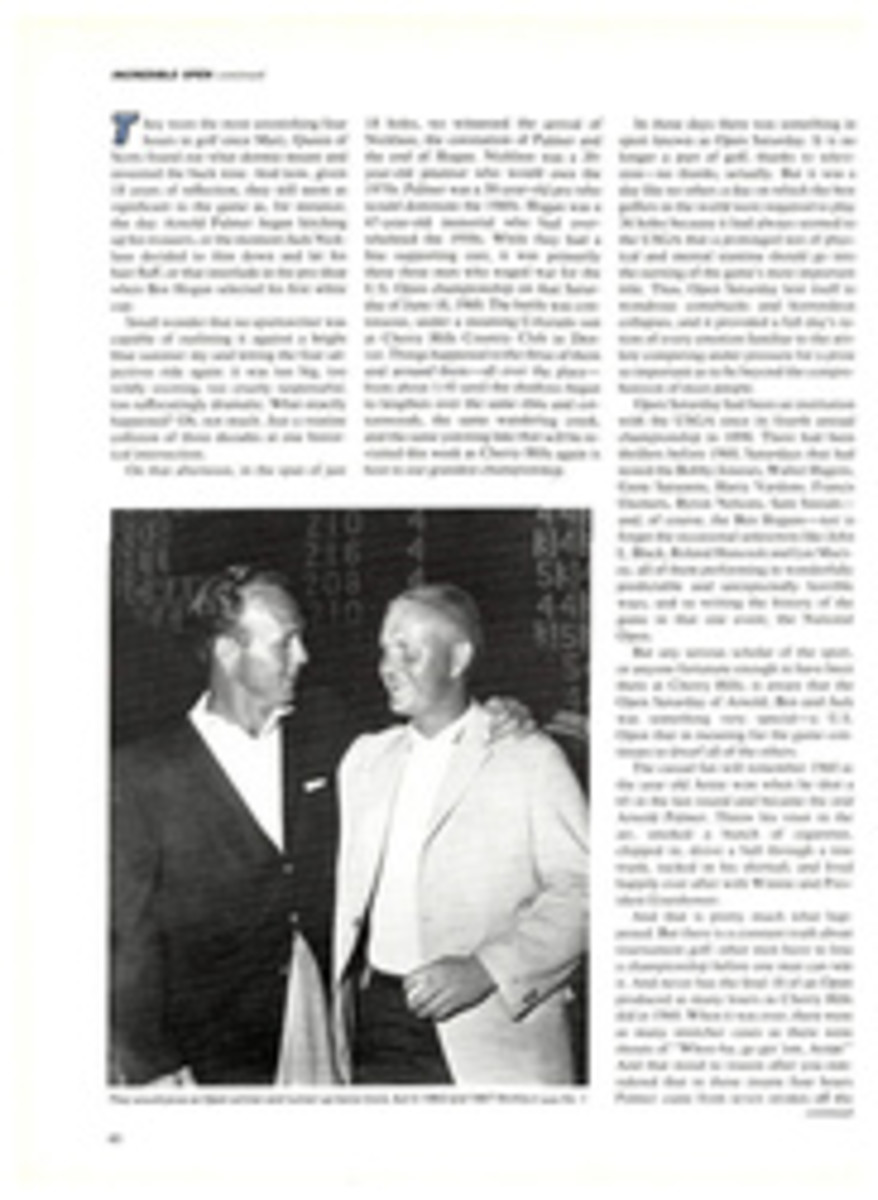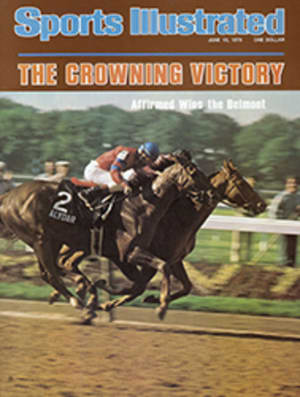
19TH HOLE: THE READERS TAKE OVER
RUNNING ON
Sir:
After reading Frank Deford's thoughtful appraisal of runners and of the articles and books pertaining to running (VIEWPOINT, June 5), I can only say that his attitude has further convinced me of what I knew all along: SI and its writers are clearly devoted to cars, horses and boats, and inspiring games of poker, bridge and Frisbee, notwithstanding a knee-jerk worship of baseball, basketball and football.
As for bores, the biggest ones I've ever met are pompous sportswriters who pretend to know what sport is about. I don't claim to have a monopoly on the subject either, but I'm very sure any magazine that considers a horse among the athletes of the year and gives virtually no coverage to a sports event like the Boston Marathon is way out in leftfield in regard to its perception of what athletics is about. I'm sure Deford is most comfortable in leftfield.
You're lucky to have Kenny Moore! See you on the road, Frank.
BILL RODGERS
Boston
Sir:
Running—or jogging—is a sport and just about anyone can participate. That is why it is catching on like wildfire. People who have never thrown a baseball, caught a football or dribbled a basketball are putting on running shoes and becoming participants rather than spectators for the first time in their lives. And you know what, Frank Deford? They love it!
Aside from the exercise, other aspects of running are good. Try to find even a half-serious runner who smokes, drinks in excess or doesn't keep a watchful eye on his diet. I can't find any. May God bless every one of the movie stars, grandmothers, children, women and doctors Deford speaks of so harshly. They are doing something for themselves. Who knows, maybe even editorial writers can conquer fat, laziness and boredom with a pair of running shoes. Try it, Frank; you might just like it.
ANDY L. FRAZIER
Orange, Texas
Sir:
I'd like to know who is twisting Frank Deford's arm to read anything. Has Frank Shorter discovered a way to put subliminal messages into Deford's morning coffee? Is Bill Rodgers whispering down his chimney? The truth is that because of all these articles on running, people are finally doing what they should have been doing all along—taking care of their bodies.
I concur that there are too many articles on running. But isn't it sad that running had to be rediscovered by a nation that otherwise might not be suffering from sedentary habits, obesity and heart disease?
CANDICE C. GILMAN
East Hartford, Conn.
Sir:
Writing about boredom must be the ultimate bore. Just please spare me tales of how bored you are, Frank.
AL MIRMELSTEIN
Charlottesville, Va.
Sir:
Although I am an enthusiastic runner, I agree with Frank Deford. In fact, a running industry has developed whose aim is to convince us that running is more important than it really is. The effects of this running hustle go beyond the mere creation of boredom. They threaten to make work out of play and organization out of spontaneity.
NEAL MILNER
Honolulu
Sir:
Leave it to Frank Deford to put salve on my wounds. He has, I feel, finally put some sorely needed thumbtacks inside this country's collective jogging shoe. He has vented what we all know to be true, viz. a bore is a bore is a bore is a runner. See Erich Segal for references.
I fully expect that a "Bore War" has been touched off and that there will be a flood of epistles from irate runners, serving only to widen the yawn associated with the already burgeoning genre of Ennui Chic. I will now quickly conclude, lest I be accused of producing a "run-on" paragraph.
KEVIN J. MALLOY
Rochester, N. Y.
Sir:
A Pulitzer, at least, for Frank Deford for shoving jogger bores into the pits where they belong.
GEORGE BEAHON
Rochester, N.Y.
CARDINAL CATCHER
Sir:
As a St. Louis Cardinal fan living in enemy territory, I often hear rabid Cub fans heap abuse upon my team. Possibly the most reviled Cardinal of all has been Ted Simmons, which is not surprising, because Simmons has hit .356 lifetime in Wrigley Field. Thank you for helping to set the record straight on him (He's Some Piece of Work, June 5). Maybe your article will quiet the hecklers.
My only quibble is that you might have gone further than to say that Simmons is the equal of the Publicized Three—Johnny Bench, Thurmon Munson and Carlton Fisk. Conceivably Munson is in a class with Simmons, but neither Bench nor Fisk has been outstanding year in and year out. Can they claim, as Simmons can, that hitting .291 in a season means an off year? I had hoped you would point this out. Nevertheless, thank you for showing that a lack of publicity, not a lack of ability, is all that separates Simmons from the others.
STEPHEN CURRIE
Chicago
Sir:
Ted Simmons wears a Philadelphia Eagles T shirt because he likes underdogs, and "the Eagles need all the help they can get." Maybe Simmons should be wearing his own team's T shirt at home, because the Cards really can use some help.
JOHN WILCHA
Carbondale, Pa.
PENNSYLVANIA BEARS
Sir:
In the article Bearing Up Under the Strain (June 5), Bil Gilbert states that bears have suffered from civilization, then condones the actions of people who feed bears suet, marsh-mallows and sweets. The problem of people feeding bears is common in our national parks. Here man is the intruder and is cautioned to keep at a safe distance from bears—and told never to feed them.
Gilbert also mentions the fact that many people in the Poconos are upset about the hunting of black bears but fails to mention that hunters have paid millions of dollars over the years toward wildlife conservation and game management.
JEFFREY WHITE
Holliston, Mass.
Sir:
A story from Pennsylvania "bear country" referring to the sad but necessary shooting of a semitame bear that had to be destroyed because it terrorized a neighborhood appeared in a local newspaper two days after I read Bil Gilbert's article. This is often the result when supposedly intelligent people insist upon treating wild animals like guests from Walt Disney Productions.
JOHN D. FRILING
Ambler, Pa.
BACK ON THE MAP
Sir:
In his article Cornell Stayed Down on the Farm in your April 10 issue, Joe Marshall wrote, "Baltimore may still be the home of the oriole, Blaze Starr and crab cakes, but the capital of lacrosse has moved north to the scenic Finger Lakes region of New York."
In light of Johns Hopkins' 13-8 defeat of Cornell for the NCAA Division I championship (The Big Red Ended Up Red-Faced, June 5) and Roanoke's 14-13 victory over Hobart for the Division II-III title, I advise Marshall to get a new lacrosse map.
It's good to see lacrosse getting some publicity, but instead of deciding at midseason who is best, why not wait until the end, when the cream rises to the top?
BRENT A. BERGER
Hopkins 1980
Potomac, Md.
Sir:
I congratulate you for your fine article on the NCAA lacrosse final. However, further photographic coverage would have given the average reader a much greater appreciation of the last of the "fun" team sports.
For purposes of clarification, I should also point out that the implication that Navy was the national champion between 1960 and 1967 is incorrect. In 1961, the Army team, of which I was a member, was cochampion with Navy, having defeated the Middies 10-8 in the final game. Our coach, James F. (Ace) Adams, was, I believe, a member of the 1947-50 Hopkins teams. More lacrosse coverage in the spring will certainly help to spread the word about this great game.
LEONARD A. BUTLER
Lieut. Colonel, USAF
Washington, D.C.
Sir:
Two pages of trivia and nowhere is there mention of 2½-plus hours of the best defense imaginable. Cornell was held to eight goals, not because Hopkins Coach Henry (Chic) Ciccarone's wife Sue served cheesecake alongside a Big Red dummy, but because Will Hazlehurst, Mark Greenberg, Mike Sheedy, Mike Connor and others played smart one-on-one defense, slid when necessary and dominated ground-ball play at their end of the field. This coupled with Mike Federico's brilliant one-on-one saves in close shut down the Big Red offense. Note, too, that Hopkins scored only 13 points, below the winners' average score in title games. Credit Chris Kane & Co. from Cornell—they, too, played quite well. All in all, it was a first-rate defensive battle that warmed the hearts of all ex-defensemen who saw it. Certainly it deserved more credit.
ROBERT J. BARBERA
Hopkins Defense 1974
Cambridge, Mass.
RUTGERS STICKMAN
Sir:
Thank you for including Rutgers lacrosse star Tom Sweeney in the May 22 FACES IN THE CROWD. AS associate sports editor and lacrosse writer for the Rutgers Daily Targum, I would like to add that Sweeney finished the season with 50 goals, topping by six the Rutgers record for goals in a season. He had 20 assists for 70 points, third on the Rutgers list for points in a season. In addition to his 10-goal, three-assist game against C. W. Post, Sweeney had a seven-goal, one-assist game against Air Force, a six-goal, two-assist game against Bucknell, a five-goal game against Princeton and a four-goal, six-assist game against Penn State. Last year he became the first freshman in Rutgers history to receive All-America honors.
MICHAEL KLEINER
Philadelphia
BIG ED
Sir:
On reading Ron Fimrite (Past 3,000 and Still Counting, May 15) and several readers (May 29) ruminating over great hitters who were in one way or another deprived of 3,000 hits, I was struck by the fact that no one mentioned Big Ed Delahanty. At the age of 35, Delahanty had amassed 2,593 hits, along with seasons of .400, .399, .394 and .408, for a lifetime average of .346, according to The Sporting News' Daguerreotypes of Great Baseball Stars.
After terrorizing National League pitching for more than a decade with Philadelphia, he jumped over to the infant American League in 1902 and won the batting title with .376 at Washington.
Then, in the next season, on the night of July 2, 1903, he was put off a train at Fort Erie, Ontario after an altercation with a conductor. He wandered along the tracks onto the international trestle crossing the Niagara River between Fort Erie and Buffalo and, presumably, fell off into the roaring river. His body was later recovered.
DUANE NORBURG
Salina, Kans.
PRIDE OF MOUNT VERNON (CONT.)
Sir:
Reader Malcolm Gissen (May 29) brought us up to date on the stars of the 1971 Mount Vernon (N.Y.) High School basketball team. I saw two of their games but was too young (I was seven) to appreciate their greatness. However, my dad tells me often of their full-court press, organized by the 1971 coach, Vince Olsen, a friend of my family.
This letter is to tell your readers about this year's suburban wonders. The 1977-78 Mount Vernon team was undefeated and easily won the state championships. (The girls' team won the Section I AA championship.) The leader of the boys' team, Carlton (Scooter) McCray, is as talented as any high school player and will be a great asset to the University of Louisville next season.
STEVE TOVEN
Eastchester, N. Y.
Address editorial mail to SPORTS ILLUSTRATED, Time & Life Building, Rockefeller Center, New York, New York, 10020.

